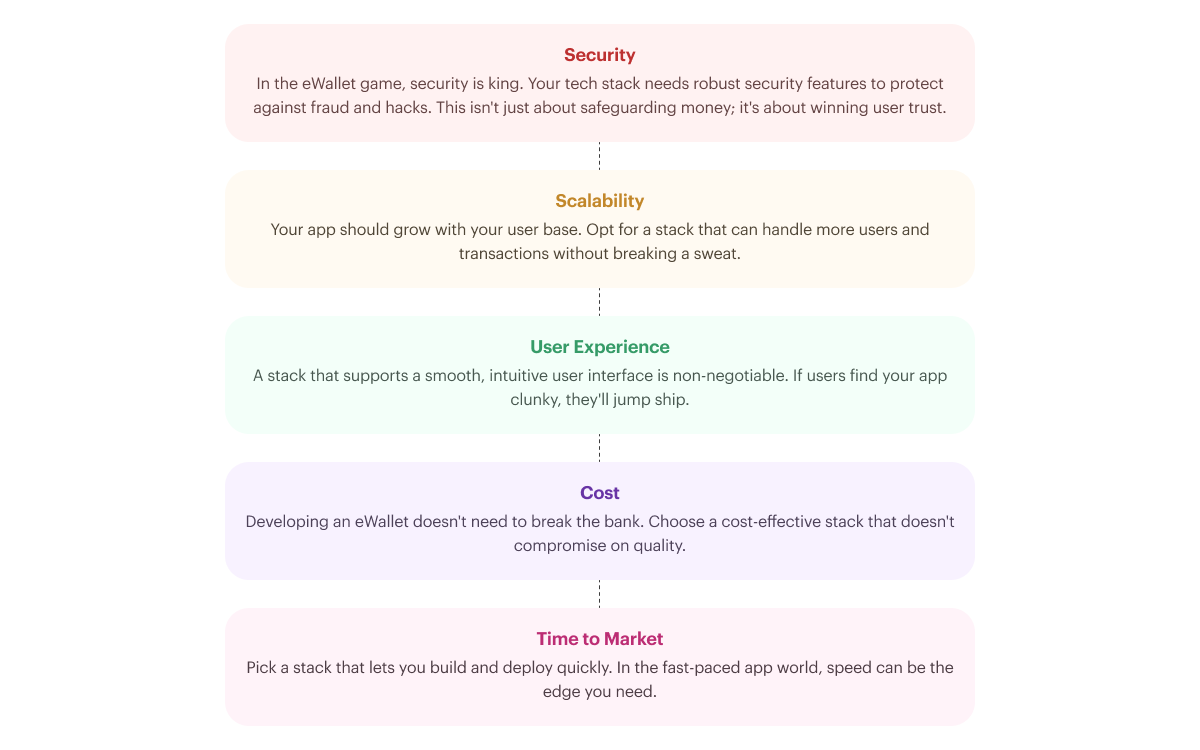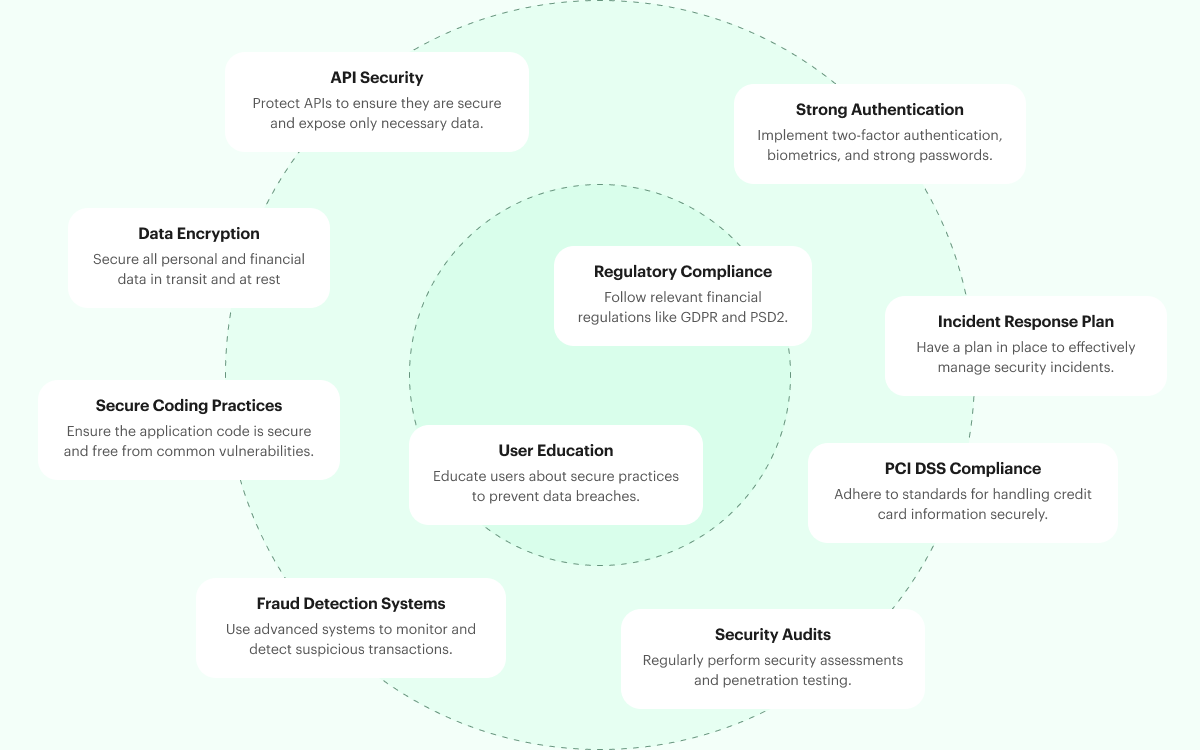If you're diving into the world of eWallet app development, you've probably hit the big question: "What technology stack should I use?" It's a crucial decision, like picking the foundation for your dream house.
Let’s explore how to choose the best tech stack for your eWallet app, ensuring it's secure, user-friendly, and ready to take on the market.
Understanding eWallet Apps
eWallet apps are digital wallets – think of them as virtual versions of your leather wallet. They securely store your money and cards, letting you make transactions with a tap on your phone.
Recent findings from Juniper Research reveal a striking surge in digital wallet usage, projecting an increase from 2.3 billion users to almost 4 billion by 2024 – that's half the global population!
It's clear they're more than just a trend; they're reshaping how we handle money.
Factors to Consider When Choosing a Technology Stack

Popular Technology Stacks for eWallet Apps
Frontend Technologies - React Native and Flutter are hot choices for creating engaging user interfaces. They're versatile, allowing for rapid development across multiple platforms.
React Native has been effectively used by PayPal to enhance its global app's performance and by Binance for a robust trading experience. On the other hand, Flutter has been utilized by Google Pay for its sleek, cross-platform interface and by Nubank to ensure a smooth and visually appealing banking app.
Backend Technologies - Node.js and Ruby on Rails offer robust backend solutions. They're great for handling the heavy lifting of data processing and security.
For instance, PayPal enhances its performance with Node.js, while Square relies on Ruby on Rails for its financial services, proving the effectiveness of these technologies in real-world eWallet applications.
Database Technologies - MySQL and MongoDB are popular databases, trusted by leading eWallets like PayPal and Venmo (MySQL) for their reliability and ability to manage vast data volumes, and Skrill (MongoDB) for its scalability and flexible data handling.
Cloud Services - Cloud platforms like AWS and Azure provide scalability and robust infrastructure. They're essential for handling peak loads during high transaction periods.
APIs and Integrations - Your app will need to talk to banks and payment gateways. APIs are the bridge for these integrations, crucial for a seamless transaction experience.
Ensuring Security Compliance in eWallet Applications

Case Study: Successful eWallet App and Their Tech Stacks
PayPal's success story shows how choosing the right technology is crucial for eWallet apps. They use Java and Node.js, making their system strong yet easy for people to use. In 2020, this approach helped them handle $936 billion in payments. A big part of their success comes from securing things with top-notch encryption and fraud detection, attracting over 377 million users.
This example shows how the right mix of good technology and strong security is key to doing well in the eWallet world.
Best Practices in Selecting a Technology Stack
- Understand Project Needs: Clearly define the app's functionalities, scalability requirements, and performance goals.
- Prioritize Security: Choose technologies with robust security features, vital for eWallet apps handling sensitive financial data.
- Consider Scalability: Opt for a tech stack that can easily adapt to growing numbers of users and transactions.
- Team Expertise: Select technologies that align with your development team's skills and expertise.
- Assess Long-Term Viability: Focus on well-supported technologies, regularly updated, and likely to stay relevant in the long run.
Challenges and Pitfalls to Avoid
Creating a wallet app involves navigating several complex challenges:
Firstly, Security Concerns are paramount. Protecting user data and transactions requires implementing robust security measures like encryption and fraud detection systems, a task that is both intricate and critical.
Then there's Regulatory Compliance. Adhering to various financial laws, including KYC and AML policies, adds a layer of complexity, making it essential to stay updated and compliant with changing regulations.
User Experience Design also plays a crucial role. The challenge lies in simplifying complex financial processes into an intuitive, user-friendly interface that appeals to a broad user base.
Integrating with Financial Institutions requires careful handling of technical aspects and security protocols, ensuring seamless and secure financial transactions.
Lastly, Scalability and Performance are key as the user base grows. The app must manage increased traffic and transactions efficiently, requiring a strong backend and continuous optimization.
Each of these aspects demands careful consideration and strategic planning, making the development of a wallet app a challenging yet rewarding endeavor.
Future Trends in eWallet App Development
Keep an eye on blockchain and AI. They're set to revolutionize security and user experience in eWallet apps. The tech landscape is always evolving, so stay curious and adaptable.
Conclusion
Choosing the right technology stack for your eWallet app is a blend of art and science. It's about balancing cost, usability, and scalability while keeping an eye on future trends. Take the time to make an informed decision – it's the foundation upon which your app's success will be built.
Frequently Asked Questions and Answers on eWallet App Development
Question 1: What is a technology stack in eWallet app development?
Answer: It's a set of programming languages, tools, and frameworks used to build the app. It's important because it affects the app's performance, security, and user experience.
Question 2: How does the tech stack impact an eWallet app's security?
Answer: The stack determines the app's security features, such as encryption and fraud detection, crucial for protecting user data and transactions.
Question 3: What to consider for scalability in tech stack?
Answer: Choose a stack that can handle increased users and transactions efficiently, with good resource management and performance.
Question 4: Relation between UX design and tech stack in eWallet apps?
Answer: The frontend technology in the stack affects the user interface's effectiveness and user satisfaction.

